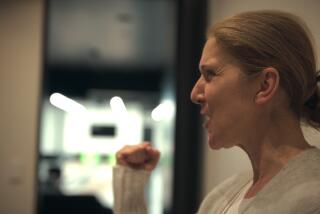It’s best to let Keaton be Keaton
- Share via
Maybe it’s because Diane Keaton first became famous for playing Annie Hall, a character that Woody Allen named and modeled after her, that the promise of her playing a true-to-type character is always so appealing. (Keaton’s real surname is Hall, and Annie is a nickname.) What we think of when we think of Keaton is a free spirit, a nonconformist, a person who says what she thinks even if it gets her in trouble, and even if it takes her a while to blurt it out.
However exaggerated or idealized a version of her, that character is a big part of the reason she’s been a genuine draw for 30 years. We want to see what’s happened to Annie Hall since we met her in 1977, when she was wearing men’s ties and vests and venturing out on her own for the first time to pursue a singing career and see where life took her.
What happened almost resembles the plot of a Woody Allen movie: A character based on an actress who played herself pops up, Zelig-like, over the next 30 years, in the most unlikely places. Unreleased or barely seen comedies starring Dax Shepard and Jon Heder, for instance.
In interviews, Keaton has said that before she landed the lead in 2003’s “Something’s Gotta Give,” nobody but its director, Nancy Meyers, was interested in casting her. She’s said that nobody thought of her for 1996’s “First Wives Club” either -- she had to lobby for the part. And for that matter, Disney wasn’t too hot on her for the “Father of the Bride” remakes in the early ‘90s. Taken together, and assuming they’re not figments of her legendary self-deprecation, these comments suggest that the defining characteristic of Keaton’s career is that when she makes a hit, she’s rewarded with a lull.
In “Something’s Gotta Give,” Keaton played the romantic lead opposite Jack Nicholson and Keanu Reeves. But equally -- or more -- remarkable was that she was also playing an independent, creative, self-made woman who had more on her mind than romance.
In the four films that followed, she played Mom. Not just any mom, but Problem Mom. In “The Family Stone” (2005) and “Because I Said So” (2007), she plays a monster matriarch so intrusive and manipulative that you keep wishing she’d get a job, even when she has one. Her other two films of 2007 were called “Smother” and “Mama’s Boy,” the first about a mom who moves into her son’s house, the second about a mom whose son won’t move out.
Callie Khouri’s “Mad Money” is Keaton’s first lead role since “Something’s Gotta Give,” and of all the roles she’s played since then, it’s the first to give her a chance to do what she does best -- remind us how much fun it is to watch an unconventional, charismatic, whip-smart and funny woman play something other than the foil. Bridget Cardigan (Keaton) is a housewife whose husband (Ted Danson) has been unemployed for two years after a downsizing. Determined not to lose her house, she devises a plan to rob the Federal Reserve, where she’s recently landed a job as a janitor. When the plan works, she finds she can’t stop. She’s not doing it for her husband or her children (who never call) but for herself.
The character is a privileged WASP, and she earns our empathy not by deserving it, but by winning it through her wits. Bridget is a classic Keaton character: a smart cookie who counts on others underestimating her to get away with what she wants. One gets the sense that this is how Keaton, the actress, wins us over as well.
“Mad Money” is far from her best movie but it lets Keaton bring some of herself to the role, which is what we come back for. Because what we want most is to keep seeing her as she’s made us believe she really is -- free-spirited and rebellious, and not just somebody’s mom.
--
More to Read
Only good movies
Get the Indie Focus newsletter, Mark Olsen's weekly guide to the world of cinema.
You may occasionally receive promotional content from the Los Angeles Times.







